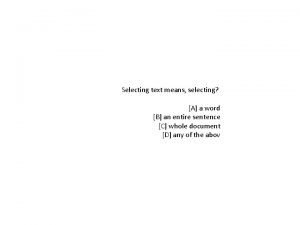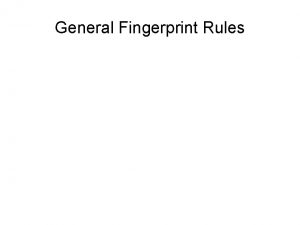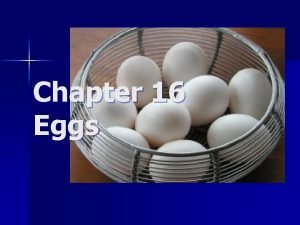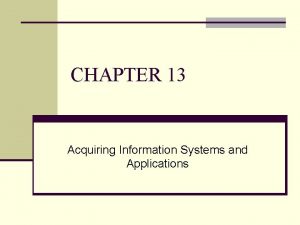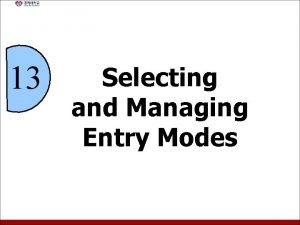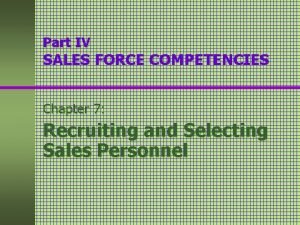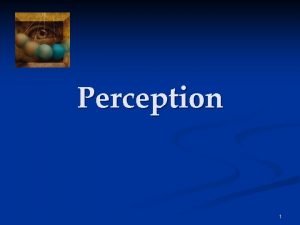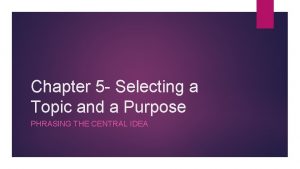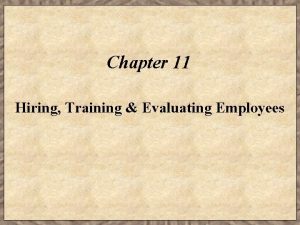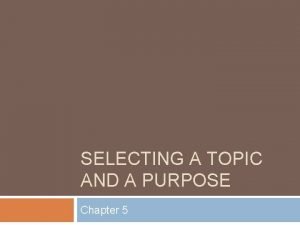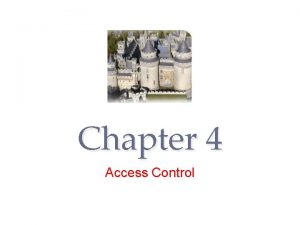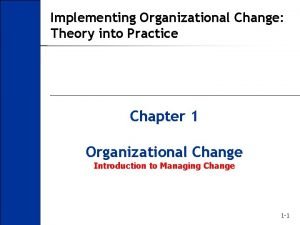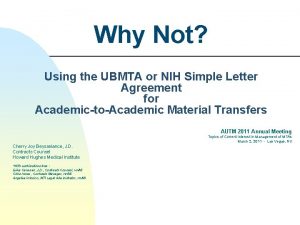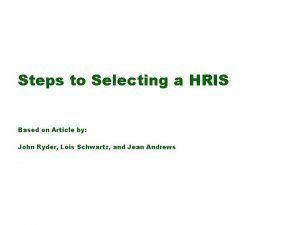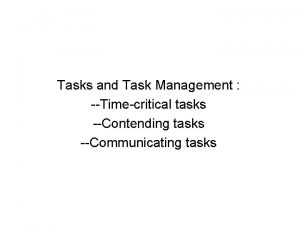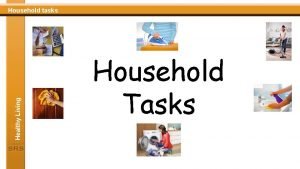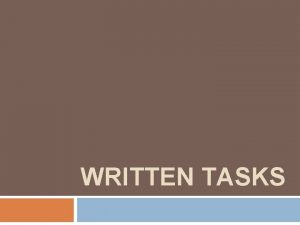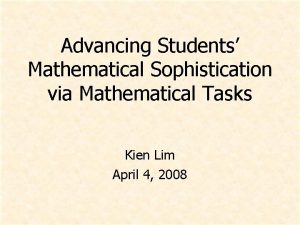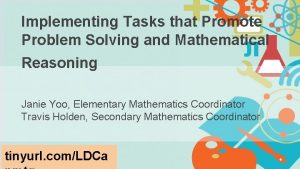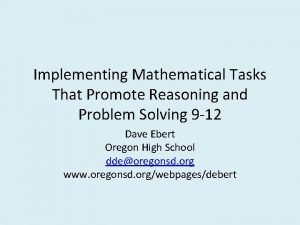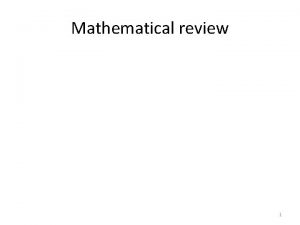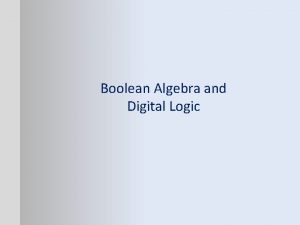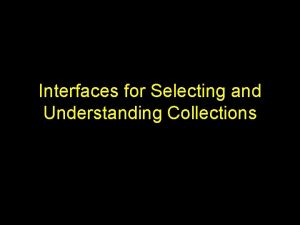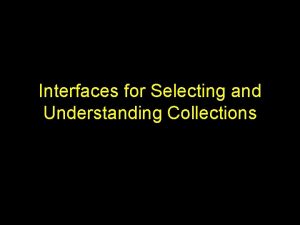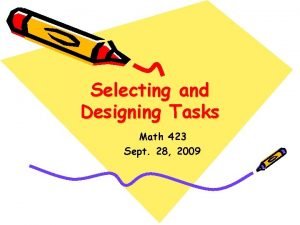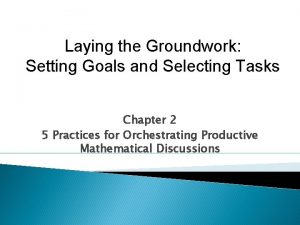Selecting and Implementing Mathematical Tasks The Importance of








































- Slides: 40

Selecting and Implementing Mathematical Tasks

The Importance of Tasks There is no decision that teachers make that has a greater impact on students’ opportunities to learn and on their perceptions about what mathematics is than the selection or creation of the tasks with which the teacher engages students in studying mathematics. Lappan & Briars, 1995

What messages are we sending?

Principles to Actions Mathematics Teaching Practices: #2 - Implement tasks that promote reasoning and problem solving. Effective teaching of mathematics engages students in solving and discussing tasks that promote mathematical reasoning and problem solving and allow multiple entry points and varied solution strategies. Principles to Actions (NCTM, 2014)

Module Learning Objectives • Recognize characteristics of high-quality tasks • Learn how to select tasks that allow the greatest opportunities for student learning • Understand how to implement and support tasks in order to maintain the cognitive level of the task

Why Focus on Tasks? • Classroom instruction is generally organized around mathematical tasks. • The tasks in which students engage determine what they learn about mathematics and how they learn it. • Not all tasks provide the same opportunities for student thinking and learning. Hiebert et al. 1997; Stein et al. 2009

Task Reflection Think of one of your favorite mathematical tasks that you use with your students. • Why is this task one of your favorites? • What was the role of the teacher and the student? • What are the essential characteristics of this task?

Comparing Tasks Review the three tasks: • How would you go about solving each task? • What are the essential characteristics of each task? • What would be a possible learning target you would have for selecting each task?

Task 1 - Bettie’s Carpeting Task Bettie is re-carpeting her bedroom with blue shag carpet. Her bedroom is 15 feet long and 10 feet wide. How many square feet of carpeting will she need to purchase?

Task 2 - Fencing Task We are raising chickens for the science fair. We have twenty-four feet of fencing to build a rectangular pen for the chickens. • How long are the sides that give the chickens as much room as possible? • How long are the sides if only 16 feet of fencing is used? • How would you determine the pen with the most room for any amount of fencing?

Task 3 - Comparing Area Game 1. Work with a partner. Shuffle the cards and place them face down in a pile. 2. Take turns turning over a card and finding the area of each figure. The player with the larger area takes both cards. If both areas are equal, players turn over a second card and compare them. 3. Continue until one player has no cards left.

Comparing Tasks • • • How are the tasks alike? How are the tasks different? What skills were employed in solving each task? What are the essential characteristics of each task? What would be the purpose or possible learning target for selecting each task?

Comparing Tasks • Which task promotes reasoning and problem solving? • Which task requires more in-depth thinking and causes students to be more intellectually engaged?

Task Sort the task cards into two piles: • Tasks you consider to be more intellectually engaging tasks • Tasks you consider to be less intellectually engaging tasks *Think about intellectual engagement, not difficulty

Distinguishing Between Tasks What characteristics helped you distinguish between the tasks’ levels of intellectual engagement? • What are common characteristics of the more intellectually engaging tasks? • What are common characteristics of the less intellectually engaging tasks?

Levels of Cognitive Demand Stein and colleagues developed a taxonomy of mathematical tasks based on the kind and level of thinking required to solve them. Lower-level Cognitive Demand Higher-level Cognitive Demand Memorization Procedures without connections Procedures with connections Doing mathematics

Levels of Cognitive Demand • In your group, read the characteristics of the level of demand. • Create a poster or graphic that summarizes the characteristics of the level of demand. • Find an example of a task that exemplifies this level of cognitive demand. • Where would you place the area tasks?

Higher-level Cognitive Demand Tasks • Allow students to engage in active inquiry and exploration • Encourage students to use procedures in ways that are meaningfully connected with concepts or understanding • Focus on reasoning and problem solving • Make possible multiple entry points and varied solution strategies

Task 2: Higher-level Demand We are raising chickens for the science fair. We have twenty-four feet of fencing to build a rectangular pen for the chickens. • How long are the sides that give the chickens as much room as possible? • How long are the sides if only 16 feet of fencing is used? Sequence of • How would you determine the pen with the most room necessary steps is for any amount of fencing? unspecified Requires expl oration and understa ay w h t nding a p No ask of math concep t y b d e t ts sugges and relationsh ips No overarching rule or procedure can be applied for solving the entire problem be n a c m e l b o Pr n i d e t n e s e r rep ys multiple wa

Lower-level Cognitive Demand Tasks • Encourage students to use procedures, formulas, or algorithms in ways that are not actively linked to meaning • Consist primarily of memorization or the reproduction of previously memorized facts

Task 1: Lower-level Demand Bettie is recarpeting her bedroom with blue shag carpet. Her bedroom is 15 feet long and 10 feet wide. How many square feet of carpeting will she need to purchase? Procedure is strongly implied in the problem n o s i s u Foc a g n i c u d pro t h g i r e l sing answer Requires no connection to concepts or meaning Little ambig uity about what has to be done and how to do it

Task 3: Lower-level Demand Comparing Area Game: 1. Work with a partner. Shuffle the cards and place them face down in a pile. 2. Take turns turning over a card and finding the area of each figure. The player with the larger area takes both cards. If both areas are equal, players turn over a No connection to the conce pts or second card and compare them. Continue m eaning th n o d e at until one player has no cards left. Focus und ct e r r o c g n i c produ er h t a r s r e w s an ing p o l e v e d n tha cal i t a m e h t a m ing understand Requires limited cognitive demand for successful completion ic m h t i r o g l A e is r u d e c o r P or f d e l l a c ly specifical erlie the procedure s

Student Learning Student learning is greatest in classrooms where the tasks consistently encourage high-level student thinking and reasoning and least in classrooms where the tasks are routinely procedural in nature. Boaler & Staples, 2008; Hiebert & Wearne, 1993; Stein & Lane, 1996 Principles to Actions, p. 17 What types of tasks are you consistently implementing in your classroom?

Lower-level Cognitive Demand Tasks that focus on learning and applying procedures do have a place in the curriculum. • What is an appropriate time and place for low-level cognitive demand tasks? • When and how might you use low-level cognitive demand tasks?

Lower-level Cognitive Demand Tasks that focus on learning and applying procedures should build on and emerge from problem-solving experiences. Cautions on using low-level cognitive demand tasks: • Should not dominate instruction • Should not preempt the use of tasks that promote reasoning

Task Implementation Tasks with high cognitive demands are the most difficult to implement well and are often transformed into less demanding tasks during instruction. Stein, Grover, & Henningsen, 1996; Stigler & Hiebert, 2004 Principles to Actions, p. 17 • Why do you think it is difficult to maintain the cognitive demand of a high-level task? • What factors might lead to the decline of a high-cognitive demand task?

Task Implementation • Read each classroom vignette. • Discuss how each teacher implements the task. • What do you notice about the teacher-student interactions? • Which teacher provides the appropriate level of support without reducing the level of the task?

Task Implementation Vignette #1 & #2 • Too much scaffolding, constraining opportunities to think through and persevere. • Teachers provide students with specific pathways to follow in order to solve the task.

Task Implementation Vignette #3 • There is right amount of scaffolding, resulting in productive struggle; the teacher didn’t hesitate to get involved to help students who were off task or stuck, but she didn’t reduce cognitive demands. • She asked questions that pushed students to think through possible solutions on their own.

Task Implementation Vignette #4 • There is too little scaffolding, resulting in unsystematic exploration and low engagement with the task.

Task Implementation NCTM recommends: Teachers must decide what aspects of a task to highlight, how to organize and orchestrate the work of students, what questions to ask to challenge those with varied levels of expertise, and how to support students without taking over the process of thinking for them and thus eliminating the challenge. NCTM, 2000, p. 19

Task Implementation Sort the factors into two categories: • Factors associated with the decline of highcognitive demand tasks • Factors associated with the maintenance of highcognitive demand tasks

Decline of High-Cognitive Demand Tasks • Routinizing problematic aspects of the task • Shifting the emphasis from meaning, concepts, or understanding to the correctness or completeness of the answer • Providing insufficient time to wrestle with the demanding aspects of the task or so much time that students drift into off-task behavior • Engaging in high-level cognitive activities is prevented due to classroom management problems • Specifying explicit procedures or steps to perform • Selecting a task that is inappropriate for a given group of students • Failing to hold students accountable for high-level products or processes

Maintenance of High-Cognitive Demand Tasks • Support for student thinking and reasoning is provided and encouraged through feedback • Providing a means by which students can monitor their own progress • Modeling of high-level performance by teacher or students • Pressing for justifications, explanations, and/or meaning through questioning, comments, and/or feedback • Selecting tasks that build on students’ prior knowledge • Drawing frequent conceptual connections • Providing sufficient time to explore

Task Implementation • Discuss the challenges with maintaining high cognitive demand tasks. • How can we prevent the decline of high cognitive demand tasks?

PD Reflection Reflect on your selection and implementation of tasks. • What aspects of the module will influence your task selection during the upcoming school year? • Develop three important suggestions for implementing and maintaining high-cognitive demand tasks that can be shared with your colleagues.

References Boaler, J. , & Staples, M. (2008). Creating mathematical futures through an equitable teaching approach: The case of railside school. Teachers College Record, 110, 3, 608 -45. Friel, S. N. , Goodson-Epsy, T. , Gleason, J. , & Gunter, T. (2008). Place Value Task Cards [pdf document]. North Carolina Elementary Mathematics Add-On License Program. Hiebert, J. , Carpenter, T. P. , Fennema, E. , Fuson, K. C. , Wearne, D. , Murray, H. , Olivier, A. & Human, P. (1997). Making Sense: Teaching and Learning Mathematics with Understanding. Portsmouth, NH: Heinemann. Hiebert, J. , & Wearne, D. (1993). Instructional tasks, classroom discourse, and students’ learning in second-grade arithmetic. American Educational Research Journal 30, 2, 393 -425. Lappan, G. , & Briars, D. (1995). How should mathematics be taught? In I. M. Carl (Ed. ), Prospects for school mathematics (pp. 131 -156). Reston, VA: National Council of Teachers of Mathematics. (2000). Principles and standards for school mathematics. Reston, VA: National Council of Teachers of Mathematics. (2014). Principles to actions: ensuring mathematical success for all. Reston, VA: National Council of Teachers of Mathematics.

References Smith, M. S. , & Stein, M. K. (1998). Selecting and creating mathematical tasks: From research to practice. Mathematics Teaching in the Middle School, 3, 344 -350. Stein, M. K. , Grover, B. W. , & Henningsen, M. (1996). Building student capacity for mathematical thinking and reasoning: An analysis of mathematical tasks used in reform classrooms. ” American Educational Research Journal 33, 2, 455 -88. Stein, M. K. , & Lane, S. (1996). Instructional tasks and the development of student capacity to think and reason: An analysis of the relationship between teaching and learning in a reform mathematics project. Educational Research and Evaluation 2, 1, 50 -80. Stein, M. K. , & Smith, M. S. (1998). Mathematical tasks as a framework for reflection: From research to practice. Mathematics Teaching in the Middle School, 3, 268 -275. Stein, M. K. , Smith, M. S. , Henningsen, M. , & Silver, E. A. (2009). Implementing standards-based mathematics i instruction: A casebook for professional development. 2 nd ed. New York: Teachers College Press. Stigler, J. W. , & Hiebert, J. (2004). Improving mathematics teaching. Educational Leadership 61, 5, 12 -16.

Tools for Teachers Writing Teams Kindergarten • • Dawne Coker, Lead Lynne Allen Leigh Belford Carol Midgett First Grade • • Martha Butler, Lead Felisia Gulledge, Lead Laura Baker Danielle Long Second Grade • • Tery Gunter, Lead Carly Morton Dianne Wells Isaac Wells Third Grade • • Leanne Daughtry, Lead Robin Hiatt Meg Mc. Kee Kaneka Turner Fourth Grade • • Ana Floyd, Lead Lisa Garrison Shelly Harris Deanna Wiles Fifth Grade • • Marta Garcia, Lead Susan Copeland Brandi Newell Rebekah Lonon

Tools for Teachers Staff • Kelly De. Long, Co-PI and Project Manager • Kayonna Pitchford, Co-PI and IHE • Janet Johnson, Outside Evaluator • Jeane Joyner, IHE and Reviewer • Katie Mawhinney, IHE and Reviewer • Drew Polly, IHE and Reviewer • Wendy Rich, K-5 Coordination and Reviewer • Catherine Stein, IHE and Project Liaison Please give appropriate credit to the Tools for Teachers project when using these materials.
 Selecting text means selecting
Selecting text means selecting Vdoe rich tasks
Vdoe rich tasks Vdoe rich mathematical tasks
Vdoe rich mathematical tasks Mathematical economics vs non mathematical economics
Mathematical economics vs non mathematical economics Implementing strategies management and operations issues
Implementing strategies management and operations issues Strategic management chapter 7
Strategic management chapter 7 Implementing strategies: management and operations issues
Implementing strategies: management and operations issues Tripod of pricing
Tripod of pricing Toyota brand hierarchy
Toyota brand hierarchy Designing and implementing branding strategies
Designing and implementing branding strategies Crm vision statement examples
Crm vision statement examples Strategic business unit structure
Strategic business unit structure Toyota brand hierarchy
Toyota brand hierarchy Ch 7
Ch 7 Recruiting for international assignments
Recruiting for international assignments Write the ( 5 ) rules in the selection of delta.
Write the ( 5 ) rules in the selection of delta. Potential development projects can be identified by:
Potential development projects can be identified by: Selecting and storing eggs
Selecting and storing eggs Steps for selecting and acquiring an information system
Steps for selecting and acquiring an information system Potential market
Potential market Recruiting and selecting sales personnel
Recruiting and selecting sales personnel Selecting organizing and interpreting information
Selecting organizing and interpreting information Selecting a topic and purpose
Selecting a topic and purpose The process of selecting training and evaluating employees
The process of selecting training and evaluating employees Chapter 5 selecting a topic and a purpose
Chapter 5 selecting a topic and a purpose Specific purpose statements
Specific purpose statements Implementing hrd programs
Implementing hrd programs Retail management notes doc
Retail management notes doc Process oriented learning competencies
Process oriented learning competencies Implementing qsen competencies
Implementing qsen competencies Challenges of implementing predictive analytics
Challenges of implementing predictive analytics Implementing organizational change spector
Implementing organizational change spector Finance and accounting issues in strategy implementation
Finance and accounting issues in strategy implementation Access rights definition
Access rights definition Keys to successful project portfolio management
Keys to successful project portfolio management Nfpa 1600 standard
Nfpa 1600 standard Implementing organizational change theory into practice
Implementing organizational change theory into practice Ubmta signatories
Ubmta signatories Nfpa business continuity
Nfpa business continuity Stateful firewall
Stateful firewall Sv-hris
Sv-hris
